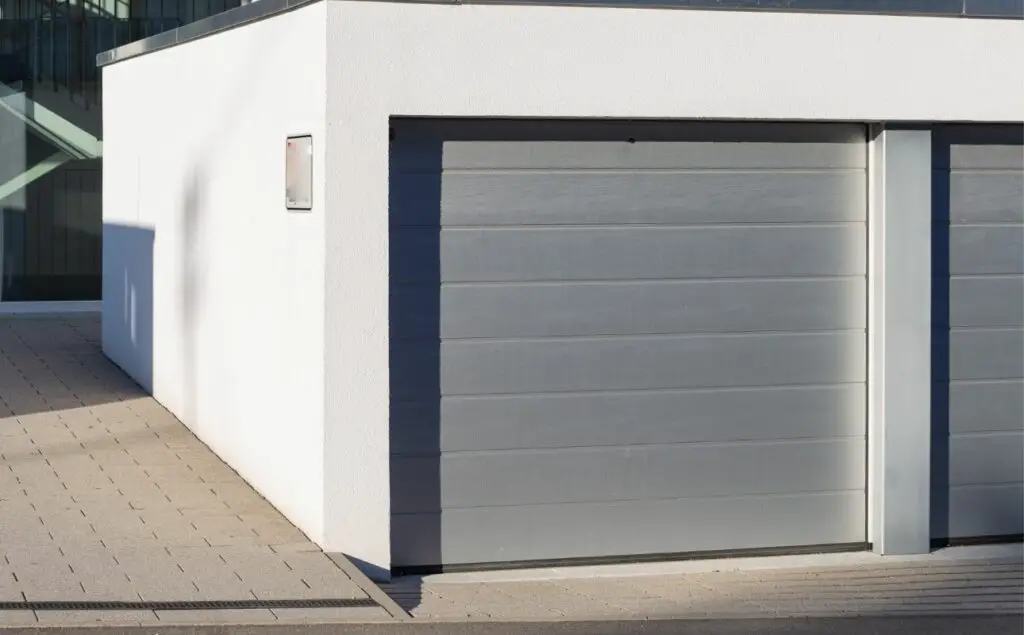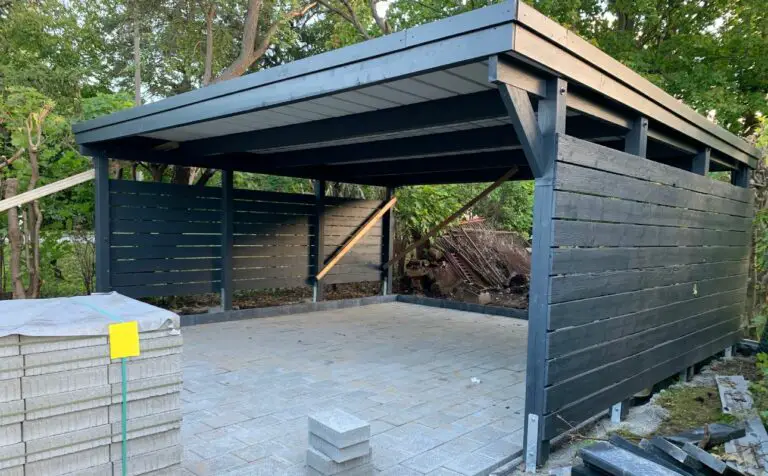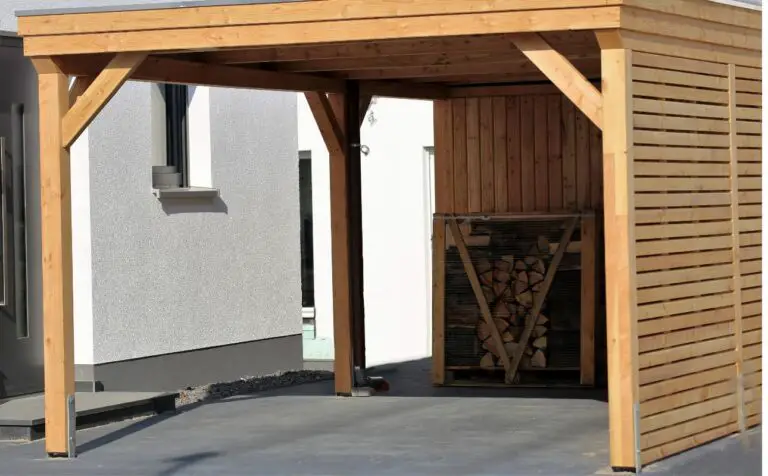While carports traditionally offer a roof and open sides, there has been a growing trend in adding walls to these structures. This has led many homeowners to wonder whether it is possible to add walls to their existing carport or if it is better to build one from scratch.
If you view your carport as more than just a place for parking cars but also storage for additional items like garden tools and equipment then adding side panels might be ideal since they keep out unwanted debris from entering the space.
Alternatively, if you live in an area where harsh weather conditions are frequent then having all four sides enclosed will provide optimal protection for both your vehicle(s) and belongings stored inside the structure.
In this article, we will explore the benefits of adding walls to your carport, the various types of walls available, factors that need consideration before installation, and upkeep requirements.

Benefits of Adding Walls to Your Carport
Adding walls to your carport can provide several benefits and enhance its functionality. Here are some advantages of adding walls to your carport:
- Increased Security
Walls offer an additional layer of security for your vehicles. They act as a barrier, deterring unauthorized access and protecting your vehicles from theft or vandalism. Walls can be equipped with doors and locks to provide even greater security.
- Enhanced Protection from Weather Elements
Walls provide better protection from harsh weather conditions such as wind, rain, snow, and hail. They create a shield around your vehicles, minimizing exposure to the elements and reducing the risk of damage.
- Improved Privacy
With walls enclosing your carport, you gain increased privacy for your vehicles. This can be beneficial if you have valuable vehicles or simply prefer to keep your vehicles out of sight.
- Additional Storage Space
By adding walls to your carport, you create an enclosed area that can be utilized for storage purposes. You can store tools, equipment, bicycles, or other items safely and conveniently within the enclosed space.
- Versatility and Multi-purpose Use
A carport with walls can serve multiple purposes. It can function as a garage, workshop, hobby space, or even a small living area. The enclosed space offers flexibility for various uses, depending on your needs.
- Aesthetics and Integration
Walls can enhance the overall look and appearance of your carport. They can be designed to match the architectural style of your home or blend seamlessly with your property’s aesthetics. This integration can add value to your property and contribute to its visual appeal.
- Improved Insulation and Climate Control
Walls provide better insulation compared to an open carport. They can help regulate temperatures and reduce the impact of extreme weather conditions. If you intend to use the enclosed space for activities that require a controlled climate, such as a workshop or home office, walls can provide a more comfortable environment.
Types of Walls for Your Carport
When adding walls to your carport, you have several options for the type of walls to use. The choice of wall material depends on factors such as budget, desired aesthetics, climate conditions, and intended use of the enclosed space.
Here are some common types of walls used for carports:
- Metal Panels: Metal panels, such as steel or aluminum, are a popular choice for carport walls. They are durable, provide excellent security, and can withstand harsh weather conditions. Metal panels are available in different colors and can be customized to match the design of your carport.
- Wood Panels: Wood panels offer a more traditional and natural look for your carport walls. They can be made from various types of wood, including cedar or redwood, which are known for their resistance to decay and insect damage. Wood panels provide good insulation and can be painted or stained to enhance their appearance.
- Vinyl Siding: Vinyl siding is a low-maintenance option for carport walls. It is resistant to rot, insects, and fading, making it a durable choice. Vinyl siding comes in a range of colors and styles, allowing you to customize the look of your carport.
- Polycarbonate Panels: Polycarbonate panels are a lightweight and translucent option for carport walls. They allow natural light to enter the enclosed space while providing protection from the elements. Polycarbonate panels are impact-resistant and offer good thermal insulation.
- Concrete Blocks: Concrete blocks can be used to create solid and sturdy walls for your carport. They provide excellent security and can withstand extreme weather conditions. Concrete blocks can be left as-is for an industrial look or finished with stucco or other coatings for a more polished appearance.
- Brick or Stone Veneer: Brick or stone veneer can be applied to the walls of your carport to add a touch of elegance and visual appeal. It provides a durable and classic look while offering good insulation properties.
How to Install Walls on Your Carport
Installing walls on your carport typically involves a series of steps to ensure a proper and secure installation. Here is a general guide on how to install walls on your carport:
- Measure and Plan: Begin by measuring the dimensions of your carport and determining the height and width of the walls you want to install. Plan the layout and placement of doors, windows, and any other desired openings.
- Prepare the Carport: Clear the carport area and remove any obstructions or debris. Ensure that the existing carport structure is sturdy and in good condition to support the added weight of the walls.
- Frame Construction: Install a framing system to support the walls. The framing can be made of wood or metal and should be securely attached to the carport structure. Follow the manufacturer’s instructions or consult with a professional to ensure proper framing.
- Install Wall Panels: Depending on the chosen wall material, such as metal panels, wood panels, or vinyl siding, begin attaching the panels to the framing. Follow the manufacturer’s guidelines for proper installation techniques, such as screwing or nailing the panels securely in place.
- Add Doors and Windows: If you plan to include doors or windows in your carport walls, carefully measure and cut openings for their installation. Install the doors and windows according to the manufacturer’s instructions, ensuring they are properly aligned, level, and securely attached.
- Insulation and Electrical Considerations: If you want to insulate the walls for better temperature control, add insulation material between the framing studs. Additionally, if you plan to have electrical outlets or lighting in the enclosed space, consult with a licensed electrician to handle the wiring and ensure compliance with electrical codes.
- Finishing Touches: Once the walls are installed, apply any desired finishing touches, such as painting or sealing, to enhance the appearance and protect the walls from the elements. Follow the recommended procedures and use appropriate materials for the chosen wall material.
- Final Inspection: Conduct a final inspection to ensure that the walls are properly installed, securely attached, and meet local building codes and regulations. Double-check for any gaps or areas that may require additional sealing or reinforcement.
Maintenance and Upkeep of Your Carport Walls
Proper maintenance and upkeep of your carport walls are essential to ensure their longevity and functionality.
Here are some key maintenance tasks to consider:
- Regular Cleaning
Periodically clean the walls to remove dirt, dust, and debris. Depending on the material, you can use a mild detergent solution and a soft brush or cloth to gently scrub the walls. Rinse thoroughly with water to remove any residue. Avoid using abrasive cleaners or tools that may damage the surface.
- Inspect for Damage
Regularly inspect the walls for any signs of damage, such as cracks, dents, or loose panels. Address these issues promptly to prevent further damage and maintain the structural integrity of the walls. Replace or repair any damaged sections as needed.
- Check for Moisture or Water Intrusion
Inspect the walls for any signs of moisture or water intrusion, such as discoloration, mold, or mildew. Address any water leaks or gaps in the walls to prevent water damage and maintain a dry and protected environment inside the carport.
- Repaint or Refinish as Needed
If your carport walls are painted or finished, monitor the condition of the paint or finish. Over time, paint may fade or peel, and finishes may wear off. Repaint or refinish the walls as needed to maintain their appearance and provide protection against the elements.
- Maintain Seals and Weatherproofing
Check the seals around windows, doors, and any other openings to ensure they are intact and properly sealed. Replace worn-out seals or weatherstripping to prevent drafts, water leaks, and insect intrusion.
- Trim Vegetation
If there are trees, shrubs, or vines near the carport walls, regularly trim them to prevent direct contact with the walls. Vegetation can cause moisture retention, promote mold growth, and potentially damage the walls over time.
- Remove Snow and Ice
If you live in an area prone to snow and ice, remove accumulated snow or ice from the walls to prevent excessive weight and potential damage. Use a snow shovel or a soft broom to gently clear the snow or ice without scratching or damaging the walls.
The Bottom Line
Adding walls to your carport can provide numerous benefits such as increased protection and privacy. You can choose from various types of walls including metal or wooden panels, brick, or concrete blocks.
According to a study by the National Fire Protection Association (NFPA), between 2014-2018 there were an average of 240 home structure fires per year that started in carports resulting in an annual average of $6 million in property damage.
Adding walls to your carport can significantly reduce these risks and potential damages caused by fire incidents. Therefore, investing in-wall installation for your carport is not only practical but also a critical safety measure for protecting your property.





